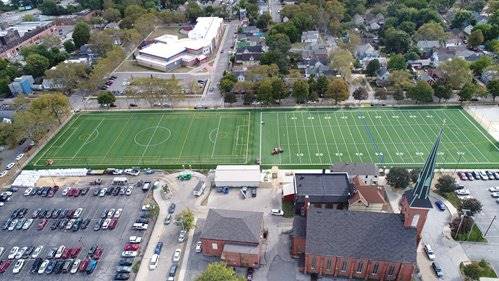The soccer program at Saint Ignatius began in the fall of 1976, founded by illustrious Classics teacher, the late Dr. Greg Knittel ‘67. It was a rag-tag group of athletes who first took the pitch for the Wildcats, consisting of those who grew up in homes where their European immigrant families lived and breathed soccer, Irish lads who saw soccer as a way to stay in shape for Gaelic football season, and the curious newcomers who just wanted to run around and kick a ball.
Fittingly, the home field for this bunch was Brookside Park. Not only had many of the guys played there on various ethnically-based teams in the Lake Erie League, but the setting – in the shadow of the Cleveland Zoo on a field littered with broken glass, syringes, doggie droppings, an occasional dead animal, and heaven knows what else – fit perfectly into the persona that Doc Knittel had imagined for his program: Inner City Soccer.
Over the years the program grew in success, but it always maintained that inner-city edginess. From the wearing of white t-shirts instead of uniforms during early pre-season scrimmages to the mysterious phone calls to suburban school opponents warning them to be very careful as they ventured from the safety of their busses to the dangerous world of the home field of the Wildcats, the reputation of Doc’s teams gave the program a certain status among the soccer elite in Greater Cleveland.
Among the players in those years was legendary present-day coach Mike McLaughlin ‘85. Coach McLaughlin was a senior when I first stepped into the world of Inner City Soccer, and his brilliance as a player became apparent to me like voting in Chicago – early and often. He was one of the notable standouts on a team that was a perfect Knittel creation – loaded with both talent and guts – and although their season ended with a disappointing shoot-out loss to a powerhouse Medina team, for me, as a first-year assistant, they set the standard for what we were trying to achieve.
These thoughts, and so many others, rushed through my brain as I stood on the brand new and immaculate McLaughlin Field last Thursday with this year’s version of Inner City Soccer. The white t-shirts were gone – replaced by matching practice jerseys, shorts and socks (at first glance I thought there must be a game and not practice) – and gone as well were the guys who played soccer to stay in shape for another sport or just to run around and kick a ball.
The romantic in me felt a bit wistful at the knowledge that the good old days of Doc Knittel and Coach Attila Farkas – our mad Hungarian pastry chef, soccer-genius assistant coach – were gone. I recalled the insane practices and unrepeatable pregame and halftime talks; I recalled the cast of characters on the field, on the sidelines, and in the stands; and I recalled the many times that opposing coaches called out home field “unplayable” right before we taught them and their teams a lesson in Inner City Soccer.
Yet, the realist in me was thrilled that the soccer program had finally “arrived.” Through the incredible work of Mike McLaughlin and his staff, especially Jim Brennan ‘85 and Joe Popelka ‘84 – coaches who, like Mike, were essential components of Inner City Soccer – soccer has become the standard-bearer for Ignatius sports in the 21st Century. Since the turn of the century, soccer has earned eight state titles and four national championships, accomplishments surpassing even the prowess of the Wildcat football teams of the 80s and 90s.
It was an honor to be invited to be present for the first ever practice on the newly turfed McLaughlin Field. It was an honor to be mentioned by Coach McLaughlin as he spoke to his team for the first time on a field that is fittingly named for him. And it was an honor to have served under both Knittel and McLaughlin, and to have been given a small role in the success of such a storied program.
In Glasgow, Scotland, supporters of the world’s greatest club, Celtic FC, talk of the move in 1892 from their old ground next to a cemetery to their new stadium as “leaving the graveyard to enter paradise.” To this day fans from around the world refer to Celtic Park as Paradise. Considering what might be buried underneath the pitch at Brookside Park, we might want to give McLaughlin Field the same nickname, especially because of the slogan used by Celtic a few years back after stadium renovations: Welcome to Paradise – Where Legends Are Made!
A.M.D.G.
*An earlier edition of this piece stated that the soccer program had won seven state championships and three national titles, not eight and four. We apologize for the error.
